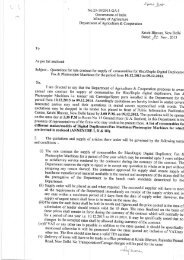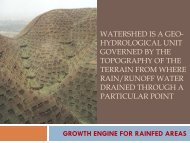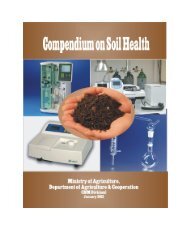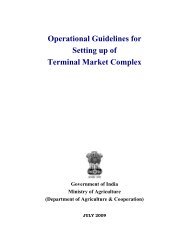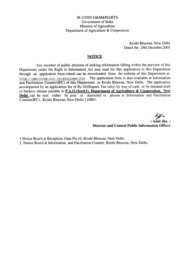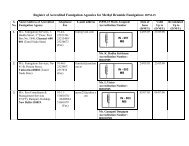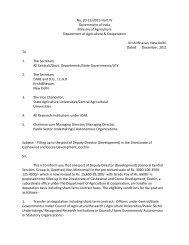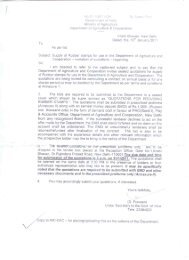Agriculture- Marketing and Infrastructure Public Private Partnership
Agriculture- Marketing and Infrastructure Public Private Partnership
Agriculture- Marketing and Infrastructure Public Private Partnership
You also want an ePaper? Increase the reach of your titles
YUMPU automatically turns print PDFs into web optimized ePapers that Google loves.
India<br />
<strong>Agriculture</strong>- <strong>Marketing</strong> <strong>and</strong> <strong>Infrastructure</strong><br />
<strong>Public</strong> <strong>Private</strong> <strong>Partnership</strong><br />
State of play <strong>and</strong> suggestions<br />
Hardeep Singh
Asia – State of Play<br />
• Role of govts in food <strong>and</strong> ag trade the last 2<br />
decades is declining - China, Indonesia,<br />
Japan…. <strong>and</strong> FSU<br />
– centralized procurement systems being replaced<br />
by private investments.<br />
– <strong>Private</strong>s emerging as co investors in infrastructure<br />
• Govts seeing they cannot over manage the<br />
commercial environment <strong>and</strong> also create a<br />
transparent arena for the private sector to get<br />
seriously involved.
Current Indian Agricultural Scenario<br />
Slowdown of sustainable value creating investments in<br />
farm sector.<br />
Proliferation of indirect subsidies.<br />
• MSP is no longer a ‘support’ price. It is a preferred<br />
price offered selectively as buyer of first resort… an<br />
unintended consequence of distorted markets<br />
• Inequity/ Largesse/ Malpractice/ Waste<br />
Lack of private investment in<br />
agricultural infrastructure, marketing,<br />
financing
Indirect Subsidies- Impact<br />
Distorted markets… Dangerously continuing<br />
Supply side thought process…<br />
Distorted cropping patterns<br />
Overexploitation of ground water – impact on<br />
recharge<br />
Costly indirect subsidies invariably do not help<br />
long term farm economy competitiveness… <strong>and</strong><br />
lead to uneconomic resource utilization<br />
Imperative need to direct public expenditure<br />
<strong>and</strong> farm subsidies towards segment focussed<br />
long term competitiveness
Foodgrain Production / Procurement<br />
Wheat + Rice prodn 160mn ts [2004-05]<br />
Govt/ FCI procures +/- 40 mn tons [25pct]<br />
- Procurement operations largely confined to<br />
traditional marketable surplus areas<br />
- >80 % of wheat from 2 States. 65 % of rice<br />
from 3 States…<br />
Farmer own consumption/ barter/ hold back –<br />
50/55pct<br />
<strong>Private</strong> Trade of surpluses - 20/25pct
Rising Support Prices Year on Year<br />
…..While world prices dropped<br />
Add > Quality deterioration/ Wastage/ Pilferage/<br />
Losses/ <strong>Infrastructure</strong> load<br />
Past accumulation of stocks far in excess of<br />
reasonable worst case need or agreed buffer<br />
stocking norms..<br />
And lost opportunity to maximise export value.<br />
Total annual World Trade –<br />
Wheat >100 mn tons / Rice
Farm policy must balance social objectives<br />
<strong>and</strong> economic considerations…<br />
Drive political consensus- sensitize polity to<br />
cost <strong>and</strong> consequences of current policy<br />
Incorporate transition mechanisms to<br />
manage change <strong>and</strong> minimise social/ political<br />
fallout
Redefining Govt Intervention 1<br />
Support<br />
Price support should be operative<br />
across a wide range of crops including<br />
oilseeds, pulses, maize <strong>and</strong> cotton, to<br />
encourage crop diversification
Redefining Govt Intervention 1<br />
Support (Cont…)<br />
Focus on remote outlying areas where<br />
infrastructure trade capability is limited.<br />
Operate countrywide<br />
FCI to be a buyer of last resort<br />
FCI price support based procurement for<br />
providing farmers with backstop security.<br />
Balance should be left to market forces
Redefining Govt Intervention 2<br />
Procurement<br />
Delink food security/ relief linked procurement from<br />
support price operations<br />
FCI to maintain approved buffer stock for specified<br />
products each quarter.<br />
Dispose off excess or acquire supplemental quantity<br />
by open tender based on crop harvest cycle<br />
Buffer Stock norms to be periodically revised<br />
Policy environment should allow privates to invest<br />
resources with a long term view - procurement,<br />
financing, storage, transportation <strong>and</strong> marketing.
Redefining Govt Intervention 3<br />
Distribution<br />
Grain distribution for public/ welfare/ relief<br />
programmes only<br />
Monetise BPL / PDS… cash or food stamps<br />
instead of grain<br />
Increase the allocation of food for work<br />
programmes, particularly where directed at<br />
building rural infrastructure<br />
Use widely networked banking system<br />
Avoid multiple h<strong>and</strong>ling/ pilferage/ waste/<br />
corruption/ infrastructure load/ Inequity
Suggested Transition Mechanisms<br />
Proportional monetary support to negatively<br />
impacted states for Rice <strong>and</strong> Wheat<br />
Linked to agreed, quantified <strong>and</strong> publicized<br />
phased reduction in Rice /wheat procurement<br />
Recommend to states to use as a per hectare<br />
direct subsidy<br />
Widely implement support prices on a broad basket<br />
of alternate crops<br />
Allay fears of marketability<br />
Drive much needed crop diversification<br />
Politically sustainable/ Socially equitable
Major Spin Off Benefits..<br />
Will align grain markets with alternate crops <strong>and</strong><br />
gradually with worldwide values<br />
Will reduce cropping distortions<br />
Will improve flow of technology/ genetics<br />
Will attract much needed private investment in grain<br />
h<strong>and</strong>ling/ infrastructure/ financing<br />
Dem<strong>and</strong> led quality / identity preservation<br />
Market led trading of surpluses <strong>and</strong> deficits<br />
Will Spur investments in food processing<br />
Will release huge funding for developing close to farm<br />
infrastructure <strong>and</strong> value adding investments<br />
Arrest l<strong>and</strong> degradation…conserve water table<br />
Will make farming long term sustainable
<strong>Public</strong> / <strong>Private</strong> partnership<br />
Interim suggestion<br />
FCI outsources procurement, h<strong>and</strong>ling <strong>and</strong><br />
distribution in select zones<br />
Frees up FCI resources for wider <strong>and</strong> ‘true’ support<br />
price operations… across a range of crops.<br />
Conserves public finances… brings in pvt capital<br />
Savings to nation<br />
Competitive behavior <strong>and</strong> disintermediation will drive down<br />
grain h<strong>and</strong>ling costs<br />
Farmer realisation will improve with more balanced <strong>and</strong><br />
equitable procurement<br />
Added benefits… employment generation close to farm<br />
Can be immediate- Minimal risk <strong>and</strong> high reward
Saathi<br />
<strong>Partnership</strong> Model<br />
Govt.<br />
Local Entrepreneur<br />
SAATHI<br />
Alliance Partners<br />
-Input Companies<br />
-Consuming Industries<br />
-Service Providers<br />
-Insurance & Banks<br />
Individual Farmers<br />
<strong>and</strong> Farmer Groups<br />
Cargill<br />
Linked Customer Access<br />
-Risk Management<br />
-Financing<br />
-Access<br />
-Intellectual Capital<br />
85 Full Service centers now operational
Grain H<strong>and</strong>ling investments<br />
-need for an integrated approach<br />
Capability/ Objectives<br />
Identity Preservation<br />
Obviate Bagging/ Cost<br />
Ease in fumigation<br />
Optimize specs/ value<br />
‘Aggregate’ quality<br />
Economy in transport<br />
<strong>and</strong> shipping<br />
Components<br />
Hopper bottom trptn<br />
primary movement<br />
railcars<br />
Silo ‘systems’<br />
at ‘both’ ends<br />
Customer interface<br />
Farmer Financing
Net Interregional Food Flows<br />
(grains, rice, oilseeds, meals, oils, feed equivalent of meat – 2003/04 crop year est)<br />
mmt surplus/deficit<br />
150<br />
120<br />
90<br />
60<br />
30<br />
0<br />
-30<br />
-60<br />
-90<br />
-120<br />
NAmer SAmer AusAsia FSU NAfri OthAfri EU MidEast FarEast
Composition of caloric intake vs. income<br />
pct of total calories<br />
100<br />
90<br />
80<br />
70<br />
60<br />
50<br />
40<br />
30<br />
20<br />
10<br />
0<br />
fish<br />
anml fats<br />
alc bevs<br />
meats<br />
sweeteners<br />
milk, eggs<br />
fruits, nuts, vegs<br />
vegoils<br />
roots, pulses<br />
cereals<br />
$270 inc, 2000 cals $2700 inc, 2900 cals $27000 inc, 3400 cals
India- Agricultural Scenario<br />
Surpluses [Myn Mts]<br />
• Wheat 2myn<br />
• Rice 3myn<br />
Deficits [Grain Equivlnt]<br />
Ts Gr Eq<br />
Vegoil 5 33<br />
Pulses 1.8 7<br />
Total Surplus 5myn ts<br />
Grain Equiv [-] 40myn ts
Leverage Country Competitiveness<br />
• Focus on commodities where<br />
India has competitive advantage<br />
& import with value of<br />
surpluses generated<br />
0.5<br />
0.4<br />
Competitiveness of Indian<br />
Crops<br />
Yield/HA<br />
Rice<br />
Wheat<br />
Corn<br />
India<br />
2.9<br />
2.5<br />
1.6<br />
US<br />
6.3<br />
2.4<br />
7.1<br />
World<br />
3.7<br />
2.5<br />
3.8<br />
China<br />
6.0<br />
3.5<br />
4.9<br />
0.3<br />
0.2<br />
0.1<br />
0<br />
-0.1<br />
-0.2<br />
Rice<br />
Wheat<br />
Corn<br />
Source : Adapted <strong>and</strong> updated from NCAER/ Gulati
Indian Vegoil Competitiveness<br />
0<br />
-0.2<br />
-0.4<br />
-0.6<br />
-0.8<br />
-1<br />
-1.2<br />
Gnut Oil<br />
Soybean<br />
Oil<br />
Sun Oil<br />
Mustard<br />
Oil<br />
-1.4<br />
Even Worse Off Relative to Palm Oil Equivalence<br />
Source : Adapted/ Updated from NCAER/ Gulati
Action Steps<br />
• Immediate serious new study on competitive advantage<br />
• Get the best brains together… Debate <strong>and</strong> decide.. Sensitise<br />
<strong>and</strong> create support.. Heighten awareness of consequences-<br />
Get politicos, banks, farmer leaders, corporates, to buy in.<br />
• Integrate <strong>Public</strong> <strong>and</strong> <strong>Private</strong> investments to align upstream<br />
<strong>and</strong> downstream within selected areas.<br />
• Protect producers in export competitive segments… <strong>and</strong><br />
consumers in others!!<br />
• Clean up unnecessary constraining legislation.. Immediate!<br />
• Plan for transition mechanisms… graded timeline<br />
Deploy the very best talent to monitor <strong>and</strong> execute plan



